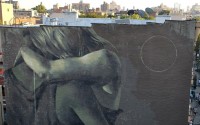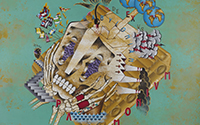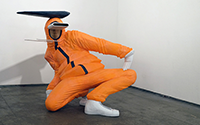This Is What Ukrainian Fairytales Look Like
By David Jenison
Interesni Kazki started out as traditional graffiti artists in Ukraine, but in 2005, the Kiev-based duo started creating street art and gallery pieces with spiritual, magical and fantastical themes in dreamlike settings. The artists—who go by the names AEC and Waone—channeled folklore, mythology and science to create otherworldly images beyond what the naked eye can see. Interesni Kazki, whose name roughly translates “Interesting Fairytale,” recently debuted a new body of work titled Sacred Gravitation on display at the Jonathan LeVine Gallery in New York City through February 6, 2016. AEC and Waone spoke with PRØHBTD about Eastern European street art, spiritual elevation, friendly angels and angry demons.

What are the main themes in Sacred Gravitation?
Waone: There isn’t one particular theme that unites all the works. It is a mix of our inspirations from the last few years: A bit of ancient Greek myths, some inspirations from Australian and Brazilian prehistoric and colonial periods, and of course some eternal topics.
AEC: Some general ideas we worked with for this show include the spiritual world and its mysterious connection to the physical world, as well as elemental theory and science.
What sources and inspirations do you draw upon to imagine the magical side of the universe?
Waone: It’s not only about this exhibition but about our art and life in general. The most inspirational thing for me is spiritual experiences and visions. The art and what I do is a way to explore the immaterial universe, which people can call the magical side.
AEC: When I am working, I use only my viewpoint and intuition based on self experience and knowledge about themes like religion, science, philosophy, mythology, history and social topics. Travelling and books help a lot when discovering new sources of inspiration.
Are there particular folk stories, myths and religious narratives in Ukrainian, Russian and Eastern European culture that influence you directly?
Waone: Yes, but not particular. I’m interested in exploring prehistoric and pre-Christian folk culture and the parallels in other cultures all over the world.
AEC: Myths and religious narratives in Ukrainian [culture] are very rich. For example, in the western part of Ukraine in the Carpathian Mountains, there is a mix of Christianity and pre-Christian, Slavic Vedic culture. A lot of shamans lives in this area and magical things are happening. I can’t say that it has influenced me directly because I don’t use any occult themes in my own works, but it is interesting to know.
What are your thoughts on cannabis, acid, mushrooms and other drugs in terms of opening people’s minds and pondering a more magical universe?
Waone: I don’t have any experience using drugs, but I’ve had spiritual visions and experiences that were super inspiring and occurred during meditation. There are two ways to open the mind: the natural way and the artificial way. The natural [way] requires a lot of work on self-development and consciousness development, and after many years of practice, you will see the result. Using drugs maybe gives a similar result and very fast, but it could be dangerous. You can unexpectedly get to hellish worlds and go crazy because the fundamental laws of physics and laws of attraction also work for the consciousness. So, if you haven’t worked on changing your consciousness to be perfect, you will be attracted to the non-perfect dimension, full of angry demons and monsters. If you have been working on your consciousness [in the natural way] to fit perfectness, you will get to a the perfect dimension with friendly angels.
AEC: I agree and think drugs that “open the mind” are dangerous because they can also close the mind. It’s an easy way to get a spiritual experience, but to achieve a real spiritual experience, some people spend their whole lives trying to reach it by asceticism. A real spiritual experience is that which gives a person understanding as to who he is, his goal in life and what happiness is. It is not some hallucination from drugs.
What is an example of a Sacred Gravitation piece that has a deeper allegorical meaning people might miss?
Waone: Among my works, it is Spark of Life. It’s about a famous scene from Michelangelo’s Creation of Adam where the spark of life passes from God’s finger to Adam’s. Everything going on around this scene is me pondering the next steps in Adam’s evolution. The final point of it is to reach the Cosmic Mind.
AEC: I can say that I didn’t reach all the meanings in what I created. Viewers can find their own references and interpret them differently. Sometimes I do work around one topic, and after I finished, I see something else.
(Editor’s note: Spark of Life is the first piece below.)









